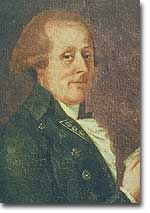|
|
|
|
 |
 Antonio
Scarpa (1752-1832). Anatomist and surgeon. He completed his
studies at the university of Padua, where he was a pupil of
the eminent doctors Vallisnieri and Morgagni. He was called
upon to teach Anatomy in Modena at the tender age of 20 and
then went on to Pavia in 1873. He was also appointed Chief
Surgeon of the Military Hospitals by Francis III of Modena.
He contributed to our knowledge of anatomical structure of
bone, the formation of bone callous, the cardiac nerves (Scarpa's
great cardiac nerve is an autonomic nerve which forms part
of the cardiac plexus.), the anatomy of the thigh (Scarpa's
femoral triangle, formed by the sartorius and the adductor
longus muscles and the inguinal ligament). Antonio
Scarpa (1752-1832). Anatomist and surgeon. He completed his
studies at the university of Padua, where he was a pupil of
the eminent doctors Vallisnieri and Morgagni. He was called
upon to teach Anatomy in Modena at the tender age of 20 and
then went on to Pavia in 1873. He was also appointed Chief
Surgeon of the Military Hospitals by Francis III of Modena.
He contributed to our knowledge of anatomical structure of
bone, the formation of bone callous, the cardiac nerves (Scarpa's
great cardiac nerve is an autonomic nerve which forms part
of the cardiac plexus.), the anatomy of the thigh (Scarpa's
femoral triangle, formed by the sartorius and the adductor
longus muscles and the inguinal ligament).
He also turned his attention to the
anatomy of the ear and described the vestibular ganglion (ganglion
originating in the vestibular nerve located at the base of
the internal auditory meatus). He also emphasised the importance
of the secondary tympanus (secondary tympanic membrane which
closes the fenestra rotunda to separate the scala tympani
from the tympanic cavity. See wax model no. XIX).
Scarpa was also famous for hernia operations and ophthalmic
surgery.
|
 |

|
|
| |
|
|
|